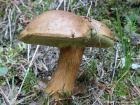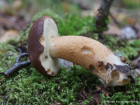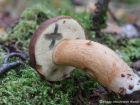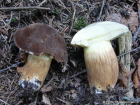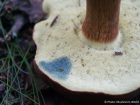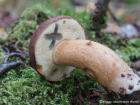Cap chestnut to dark brown, sometimes with brick-red or ochre tinges; almost spherical in young specimens before broadening and flattening out. It is at first downy, becoming smooth and polished, somewhat sticky when damp. The flesh is white or lemon-yellow. Where cut, it becomes faintly blue. Pores initially cream to pale yellow but become greenish-yellow or olive with age. Stem enlarged at the base, pale yellowish to pale brownish color near the top, transitioning to brown or reddish-brown lower down and relatively slim and cylindrical (compared to many other boletes). The stem has no ring. Spore print olivaceous-brown.
Microscopic Features: The spores are subfusiform, measuring approximately 12-15 x 4-5μm in size.
Synonyms of Imleria badia include Boletus badius, Ixocomus badius and Xerocomus badius.
Imleria badia on the First Nature Web site.
Imleria badia on the MushroomExpert.Com Web site.
Many mushrooms are poisonous, and some can be lethally toxic. Distinguishing between edible and poisonous mushrooms can be very challenging. Therefore, we strongly advise against consuming wild mushrooms. This website does not contain any information about the edibility or toxicity of mushrooms.
Although efforts have been made to ensure accuracy on this website, the information may contain errors and omissions. Therefore, all content provided is for educational and informational purposes only and should not be relied upon or used as a basis for consuming any plants or mushrooms.
External links are provided for reference only. We do not endorse or take responsibility for the content, advice, or products found on these sites or in any advertisements shown on this website.
